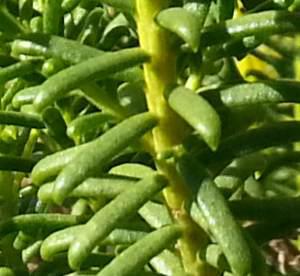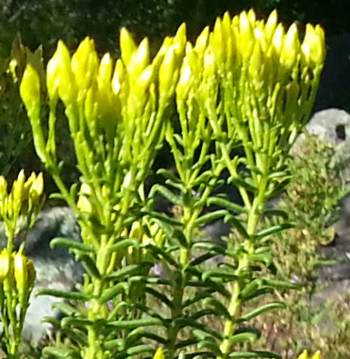Pteronia uncinata
Pteronia uncinata DC.
Family: Asteraceae
Common names: coast gumbush (Eng.); strandgombos (Afr.)
Introduction
This honey scented shrublet is a must-have for any coastal garden in the winter rainfall region of South Africa.

Description
Description
Pteronia uncinata is an erect, multi-stemmed rounded shrublet 300-900mm high. Leaves are needle-like, often in whorls of three, hairless, with revolute margins (margins rolled in beneath the leaves) and hooked tips.

Loose bunches of narrowly cylindrical, button-like, yellow flowerheads up to 10×30mm are arranged in flat-topped clusters at the ends of the branches. Flowerheads consist of four to five narrow yellow honey scented disc florets. The bracts are hairless and involucral (a number of bracts surround the base of each flowerhead). Flowering time is in summer, from December to April.

Conservation Status
Status
Pteronia uncinata is Red Listed as Least Concern, which means that this species is not threatened.
Distribution and habitat
Distribution description
Pteronia uncinata occurs naturally on coastal sands in the south-western Cape from Malmesbury to Clanwilliam (also Stillbaai). It is suitable for winter-rainfall gardens.
Derivation of name and historical aspects
History
Pteronia is derived from the word pteron, meaning wing. The species name uncinata means with hooks.
Pteronia uncinata belongs to the daisy family, Asteraceae. The Asteraceae family has 121 genera with 1036 species occurring in the Cape Floral Region. The south-western Western Cape is home to 111 genera with 517 species and 32 introduced species. It is the largest plant family in southern Africa with 264 genera containing 2481 species.
Pteronia is a large genus of shrubs with over 80 species, many occurring in Karoo-type conditions. The centre of diversity for Pteronia is the Karoo-Namib region of southern Africa with 12 species occurring in the Fynbos Biome in the Cape Floral Region. One species is found in Zimbabwe.
Ecology
Ecology
Little is known about the ecology of this plant.
Uses
Use
Pteronia uncinata is not widely used in gardens, but has great horticultural potential.
Growing Pteronia uncinata
Grow
Pteronia uncinata is best suited as a subject in a water-wise and fragrance garden, particularly when planted with Felicia aethiopica. It thrives in coastal gardens — the shrub is very striking with its yellow flowers in summer. It may look dull in winter but the foliage will remain green.
Pteronia uncinata can be grown from cuttings. Make cuttings in spring. Take cuttings early in the morning to avoid wilting. Root them in a propagation medium consisting of fine bark and polystyrene. Once planted out, give the plants compost annually to enhance their growth and performance.
References
- Brown, N. & Duncan, G. 2006. Grow Fynbos plants. South African National Biodiversity Institute, Cape Town.
- Leistner, O.A. (ed.). 2000. Seeds plants of southern Africa: families and genera. Strelitzia 10. National Botanical Institute, Pretoria.
- Manning, J. & Goldblatt, P. 1996. West Coast South African Wild Flower Guide 7. Publisher and place of publication .
- Manning, J. 2007. Field guide to Fynbos . Struik, Cape Town.
- Bohneh, P. 1995. More flowering plants of Southern Cape . The Still Bay Conservation Trust, Still Bay.
- Latin and Greek Meanings and Derivations: https://www.calflora.net/botanicalnames/pagePI_PY.html. Accessed on the 2014/01/29
- http://www.msb.unm.edu/herbarium/pteronia/ Accessed on the 2014/01/29
- http://www.ispot.org.za/sites/default/files/images/11303/4fffb55ee41c5d90c2e3a88e5f37639a.jpg Accessed 2014/01/29
Credits
Zoleka Maphanga
Millennium Seed Bank
February 2014
Plant Attributes:
Plant Type: Shrub
SA Distribution: Western Cape
Soil type: Sandy
Flowering season: Early Summer, Late Summer
PH:
Flower colour: Yellow
Aspect: Full Sun
Gardening skill: Average
Special Features:
Horticultural zones







Rate this article
Article well written and informative
Rate this plant
Is this an interesting plant?
Login to add your Comment
Back to topNot registered yet? Click here to register.